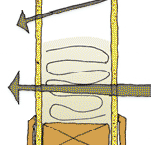- Home
- Site Analysis
- Site Use
- Passive Design
- Water
- Material Use
- Energy
- Wet Areas
- Health and Safety
- Other Resources
Passive Design
Designing the building and the spaces within it to benefit from natural light, ventilation and even temperatures.
Noise control in interior partitions
Interior noise can be controlled by sealing joints and incorporating sound-absorbing materials.
On this page:
- bulk insulation helps absorb noise
- noise control in new partitions
- noise control in existing partitions
- noise control in ceilings
- noise control in timber floors.
In general, internal sound-reducing construction should have mass and sound-absorbent material. All joints should be sealed (to minimise air gaps through which sound might pass), and – as much as possible – the structure between the linings should be discontinued.

- Reducing sound transfer through a cavity partition
The amount of sound loss through a wall will depend on the mass of the wall linings, gaps through the wall and whether an acoustical fill material has been installed.
Bulk insulation helps absorb noise
Noise transmission through wall or roof cavities or between floors can be reduced with bulk insulation – fiberglass, polyester or wool. Some products are marketed specifically for noise reduction, but even bulk thermal insulation also has this effect. MBIE has said insulation with a minimum density of 9.8 kg/m3 is required. Bulk insulation with a rating of R 1.8 meets this requirement in many cases.
Noise control in new partitions
Options for sound-reducing construction for new internal partitions:
- A standard 90 x 45 mm timber partition with two layers of 10 mm plasterboard one side, sound absorbing insulation and one or two layers of plasterboard on the other side – good noise reduction.
- A staggered stud partition with 140 x 45 mm bottom and top plates, 90 x 45 mm off-set studs, sound-absorbing insulation woven around the studs and 13 mm plasterboard on both sides – moderate noise reduction.
- Double wall construction with two 190 x 45 mm partitions and a 10 mm gap, studs in each partition off-set from the other partition, sound-absorbing insulation between studs and two layers of 10 mm plasterboard both sides – excellent noise reduction.
Solid masonry construction provides an excellent acoustic barrier as well as providing thermal mass.
Table 1. STC ratings of some typical wall constructions.
| Wall lining – side 1 | Framing | Wall lining – side 2 | Cavity infill | STC rating |
| 10 mm plasterboard | 90 x 45 mm timber (1) | 10 mm plasterboard | None | 33 |
| 10 mm plasterboard | 90 x 45 mm timber | 10 mm plasterboard | 90 mm sound insulation material | 36 |
| 150 mm concrete OR 190 mm solid filled concrete masonry | - | - | - | 55 |
| 2 x layers 13 mm plasterboard | 90 x 45 mm timber with resilient rubber mounting system | 1 x layer 13 mm plasterboard | 90 mm sound insulation material | 56 |
| 10 mm plasterboard | 190 mm solid filled concrete masonry with 45 mm strapping either side | 10 mm plasterboard | 40 mm sound insulation material | 62 (2) |
| 2 x layers 13 mm plasterboard | 2 x 90 x 45 mm double timber stud (separate frames) | 2 x layers 13 mm plasterboard | 2 x 90 mm sound insulation material | 64 |
- Steel stud systems tend to perform 1–2 points better than equivalent timber stud systems.
- Strapping and lining masonry systems must be done carefully, otherwise matched resonance can reduce rather than increase the performance of the masonry alone. To avoid problems, strapping must be a minimum of 45 mm deep and spaced 600 mm apart, and the cavity must be filled with insulation.
----------------------------------------------------------------
A key to acoustic design is ensuring that there are no gaps or paths in the completed construction through which noise can pass. This includes:
- avoiding service penetrations in the acoustic wall
- sealing around the perimeter of the wall.
Noise control in existing partitions
Options for improving sound transmission reduction to existing partitions:
- Adding an additional layer of 10 mm plasterboard on both sides of a standard timber partition.
- Removing the lining from one side of a standard timber partition, adding sound-absorbing insulation and two layers of 10 mm plasterboard on one side and another layer of 10 mm plasterboard on the other side.
- Building an additional partition beside a standard timber partition that has had the lining removed on the face adjacent to the new partition, adding sound-absorbing insulation, two layers of 10 mm plasterboard on the external face of the new partition and an additional layer of 10 mm plasterboard on the external face of the existing partition.
Noise control in ceilings
For both new and existing ceilings, improve sound transmission reduction by:
- adding an additional layer of 10 mm or 13 mm plasterboard
- removing existing lining and installing resilient batten fixings to existing battens, sound-absorbing insulation and two layers of 10 mm plasterboard.
- Removing open down-lights or other ceiling penetrations
Noise control in timber floors
Standard floor/ceiling construction with particle board or plywood flooring and a 10 mm plasterboard ceiling below has low resistance to impact noise (IIC32). Options for improving the resistance to impact noise include:
- a standard floor construction with sound absorbing insulation, a ceiling system with proprietary resilient batten fixings and steel battens and two layers of 10 mm plasterboard
- a standard floor/ceiling construction with carpet and rubber underlay
- a standard floor construction with carpet and rubber underlay, sound-absorbing insulation, a ceiling system with proprietary resilient batten fixings and steel battens, two layers of 10 mm plasterboard and carpet and rubber underlay.
Squeaking timber floors
Timber floors can generate noise by squeaking and transmitting sounds such as footsteps and scraping chairs. To avoid squeaking:
- the flooring should be glued as well as screw-fixed to the joists
- the framing must be dry (less that 24% MC) when the flooring is installed
- timber floor boards must be securely cramped and nailed.
For more help, see BRANZ bulletin BU521 Squeaky floors.
Updated: 29 August 2017

